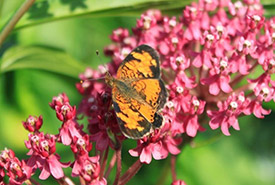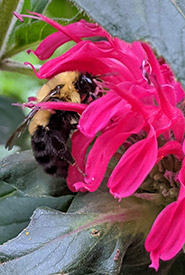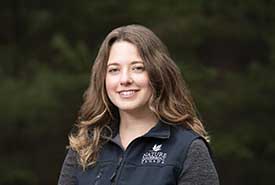My native species bring all the pollinators to the yard

Northern crescent butterfly on swamp milkweed flowers (Photo by Jaimee Morozoff/NCC staff)
Now that spring has finally made its way across Canada (in some places it was slower in arriving than others), gardening season is in full swing! With all of the choices present at our local nurseries and big box stores, it is easy to get carried away with the newest, brightest, biggest flowers and plants.
While these exotic beauties have a place in our gardens and planters, I encourage you to consider adding pollinator-friendly flowers, especially native species, to your garden and yard. Pollinators are vitally important to our natural ecosystems and our agricultural practices, yet many groups have been facing serious declines.
Pollinating insects are under strain from loss of food sources, loss of habitat, disease and pesticides. They include bees and butterflies, in addition to wasps, moths, flies and beetles, hummingbirds and bats.
Pollinators are attracted to flowers based on a variety of different characteristics, including:
- colour and scent
- amount of nectar and pollen
- shape of the flower itself
Flowers with bright colours, like blue, purple and yellow, are attractive to native pollinators. White flowers that have a strong scent are also attractive, especially to night-time pollinators. Different flower characteristics attract different types of pollinators. It is best to provide a range of plants that will benefit multiple pollinators, and will offer a progression of flower bloom times all summer long.
Native plants are often the best option for native pollinators, but old-fashioned or heirloom non-native varieties of plants and herbs can also be quite beneficial. Many popular flower varieties are hybrids and have been bred for provide bigger flowers, more disease resistance and other traits humans enjoy in garden plants. However, sometimes hybridization reduces or eliminates the production of nectar and pollen, which leaves little to no sustenance for the pollinators. When using any non-native plants in your garden, make sure they aren’t invasive in your area. If planting native plants, don’t dig them out from the roadside; instead go find a reputable native plant supplier.

Bee on a beebalm plant (Photo by Jaimee Morozoff/NCC staff)
Pollinators need more than just nectar to survive. Consider providing other important necessities for pollinators like water, habitat and host plants for other life stages. A well-known example is monarch butterfly, which only lays eggs on plants from the milkweed family, while the adults will feed on a variety of nectar sources.
Jaimée’s five favourite pollinator plants for your garden
Picking a favourite flower is next to impossible, but I compiled a list from my own personal pollinator gardens while living on the Prairies and in Nova Scotia. Find native or heirloom species in your area and enjoy watching the pollinators flock to your yard.
1. Black-eyed Susan
This prairie stunner has bright yellow leaves and dark centres. It is also a preferred nectar source of the Poweshiek skipperling, an endangered tall grass prairie butterfly.
3. Bee balm
Pretty purple flowers with an amazing scent (and the leaves smell great too). Bergamot/bee balm is an all-around good source of nectar for bees, butterflies and hummingbirds.
4. Goldenrod
A late summer bloomer that is a favourite of bees in my garden. Goldenrod can also attract native aphids, which bring a variety of other beneficial insects to eat them, including ladybugs. By leaving your goldenrod (and other plants) standing during the winter and clearing it out in the spring, you can provide valuable habitat for ladybugs and other beneficial insects.
4. Milkweed
The milkweed family not only provides larval food sources for monarchs, the flowers are also frequented by other butterflies and are very pretty. Showy milkweed and swamp milkweed are two common varieties found in Canada. Check your local jurisdiction to see if there are any rules around planting common milkweed, especially in agricultural areas.
5. Native berry shrubs
Flowering berry shrubs add visual interest and height to the edge of your garden or yard, are valuable early spring flower sources, and provide food for other species once the berries mature (or for you)! Several butterfly species also prefer these shrubs for their caterpillars. There are many different native berries like blueberry, serviceberry/Saskatoon and cherry varieties across Canada to fit your space and climate. If you live in an area of Canada that is primarily forested, these are likely to be one of the best options for native plants.
Honourable mentions
- Anything in the Aster family. Bees and butterflies alike love these plants! Lots of great native and old-fashioned options. One of my native favourites is smooth aster.
- Speedwell. While native speedwells are a great option throughout Canada, my favourite garden version is native to Europe. When they are in bloom in my garden, they are covered with bees all day long.
- Sunflowers. They come in a huge variety of sizes and colours. There are many native and old-fashioned heirloom varieties available. I like prairie sunflower.
Now, go plant some native pollinator species! I also recommend visiting some local Nature Conservancy of Canada conservation sites. Go for a hike, volunteer at a Conservation Volunteers event and get inspired by native flowers and pollinators!


